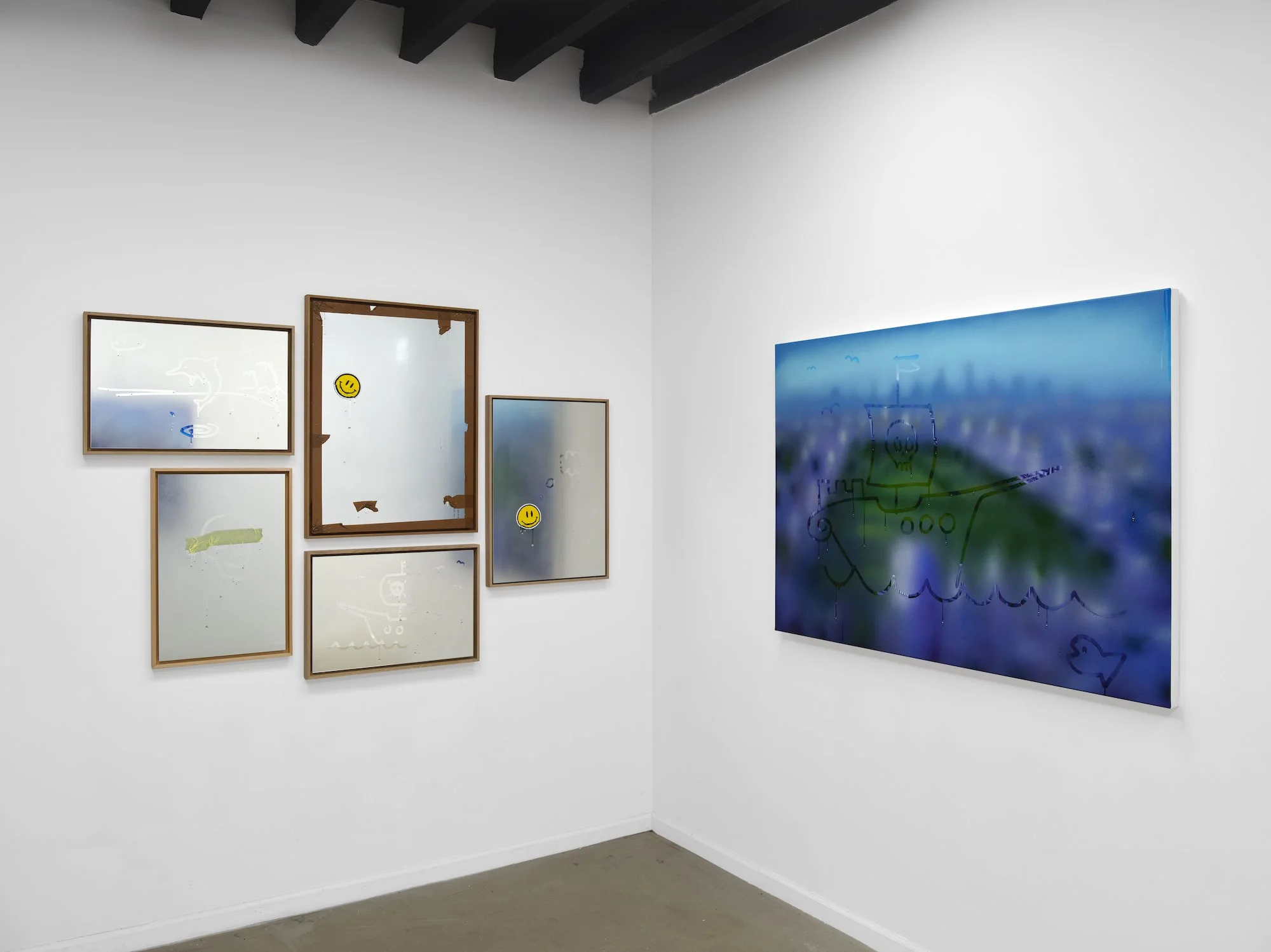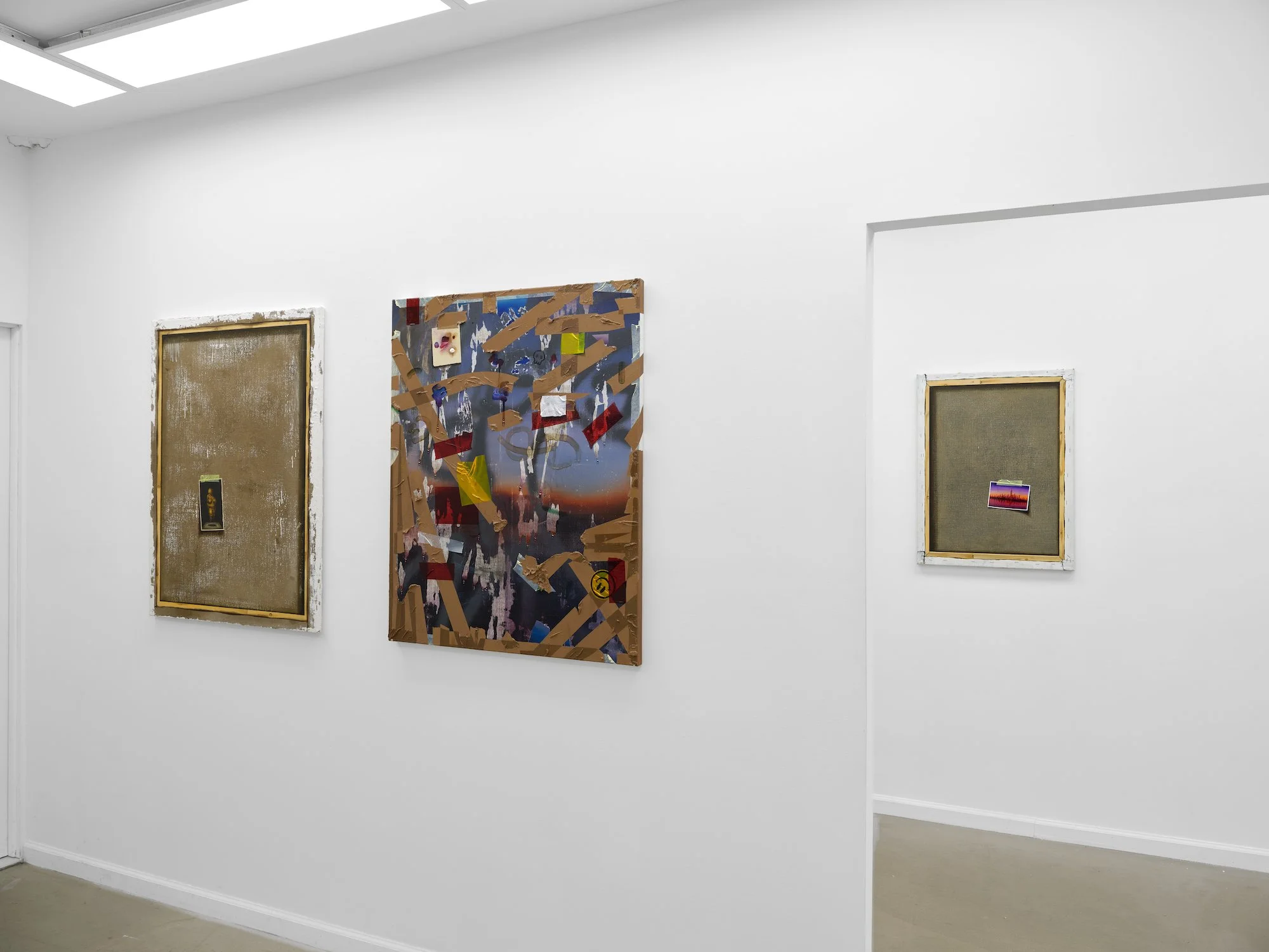Jochen Mühlenbrink’s Illusions
The forms are simple: a finger-painted smiley face, a cartoon pirate ship, an occasional dolphin, a comic-strip thought bubble. Sometimes, they’re mere gestures: a wobbly circle, a diagonal line. Simple though they are, these are some of the only legible forms in Jochen Mühlenbrink’s paintings, most recently on view at Long Story Short in New York. The images beneath (or behind) these symbols are blurry, indefinite views; landscapes through windows or reflections in fogged-up mirrors. These smileys and ships serve dual functions, inscribing their own shape while revealing that further image, obscured behind glass.
Hiding and revealing, inscription and effacement: these tensions are essential to Mühlenbrink’s practice, giving conceptual weight to what may at first glance appear simple, tongue-in-cheek pictures. From his early training at the Kunstakademie in Düsseldorf, Mühlenbrink has maintained a consistent focus on using illusionistic techniques to forge new paths in representational art.
“It was too dusty, too old,” Mühlenbrink said of the painting tradition he was immersed in during training. “I didn’t want to end up in this traditional German painting corner, so I was challenged to look for my own ways.”
His first revelation was to flip the picture on its back. His early works are trompe l’oeil renderings of canvas versos, complete with painted-on stretcher bars and rough splotches of gesso—X-rays, in a way, of what’s “behind” a painting. Then came the tape paintings, bandaged over with simulated packing tape. Mühlenbrink said he initially resisted techniques like trompe l’oeil because he thought them “kitschy,” but that by leaning into illusionism, he could move beyond painting’s perceptual dead ends.
“I started to turn around the painting, wrap it in bubble wrap, tape the painting,” Mühlenbrink said, “which brought me to new ideas of seeing, of hiding things, of questioning our perception of what we see. And then I started to have a reason to first hide the things that we think we see: to then reveal them back.”
That principle reaches a zenith in Mühlenbrink’s window paintings, which are his most striking works. He composes the fogged-over landscapes first, never working from existing images but inventing the landscape whole-cloth. He then paints over this blurred ground with his wry, prankish symbols, which themselves cut through the “condensation” to reveal slivers of otherwise-obscured detail.
“For me, discovering the moisture of the glass gave me a new reality where I can figure out what is beyond the glass, what is in front of the glass,” Mühlenbrink said. “So you have a new layer that is in between your own seeing of the picture, and your own eye and brain. There, in between, is a new reality.”
These window paintings update postwar experiments in representation to investigate what it feels like to experience images today. There’s a strain of Gerhard Richter’s blurry photorealism here—see the oneiric flames in WP BCP (2025), or the nearly-recognizable park in WP PIRATES (2025), both of which have foreboding, Richterian rinds. But Mühlenbrink’s additional painted layer of glass, his “new reality,” takes these paintings beyond the photographic image, placing them behind a mediating screen that is all too familiar. We view images now mainly by tapping on them, by sliding up or across on carousels and feeds. The window paintings, with their finger-painted symbols and obscuring glass panes, recapitulate the haptic logic of the smartphone: our images are trapped behind glass. We can look, can even try and touch. But there is something in between: the screen, the “new reality.”
That notion is taken even further in Mühlenbrink’s latest body of work, his mirror paintings, which seem to represent a sort of terminus for his investigations into perception. The mirror paintings forego all painterly representation, presenting artificially fogged mirrors scrawled with his signature symbols or taped over and stickered. To create the fogged-up effect, Mühlenbrink again looked to the past, using a spray varnish combined with an organic resin he said the Old Masters used. The effect is an even more staunch refusal of the painted image, which was the point, according to the artist.
“For the window paintings, I first painted the blurred landscape, which seems to be underneath,” Mühlenbrink explained. “But what if there is nothing underneath? Or so-called reality underneath? What if I only paint the blur, without image?”
These mirrors are almost troubling, in the context of Mühlenbrink’s forward-looking practice. They reveal no further image, only a reflection. What is there left to experience, they seem to ask, except for the screen itself and our reflections in it?
Jochen Mühlenbrink: STILL (Lifes and Dreams) was on view at Long Story Short from May 2nd to June 15th, 2025.



